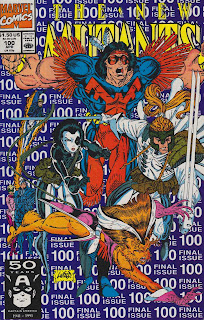Endgame Part 1: Malign Influences
Credits:
Jim Lee and Whilce Portacio (plot), Chris Claremont (script), Whilce
Portacio (penciler), Art Thibert (inker), Steve Buccellato (colors),
Michael Heisler (letters)
Summary:
Hard-Drive, a member of the Riders of the Storm, uses his powers to
hack into Ship’s network. The Riders of the Storm spy on X-Factor’s
training sequence, preparing for battle. Later, Iceman and Archangel
visit their respective girlfriends, as Beast watches footage of Trish
Tilby. Suddenly, Ship is attacked by the Riders. Psynapse invades
Marvel Girl’s mind, forcing her to relive the death of her childhood
friend. When Iceman and Archangel return, the battle goes in X-Factor’s
favor, until Apocalypse appears.
Continuity Notes:
-
The next issue identifies Apocalypse’s servants as the Riders of the Storm, who will later go by the simplified title of “Dark Riders.” As of this issue, however, they don’t even have a collective name yet.
-
Following the ending of Uncanny X-Men #273, Guido has informed Cyclops that Lila Cheney teleported the X-Men away to save Professor Xavier. Cyclops is holding the training session to be ready in case the X-Men need their help.
-
Psynapse’s invasion of Marvel Girl’s mind enables her telepathy to return. The creators drop hints this issue, but this isn’t confirmed until later.
Production Note:
The “Apocalypse Files” listed on the cover is a text piece of
Apocalypse narrating profiles of three X-Factor members, written by
Fabian Nicieza. The back-up feature is actually called the “Apocalypse
Manifesto” inside the issue.
I Love the '90s:
Trish Tilby is filing a report from the Persian Gulf regarding the
possibility of super-powered beings entering Operation: Desert Storm.
Beast’s VHS copy of the broadcast is labeled 1/24/91.
Miscellaneous Note: The Statement of Ownership has average sales at 268,307 copies, with the most recent issue selling 228,800.
Review: Chris Claremont has said that he agreed to script X-Factor for a few issues in order to get a feel for Whilce Portacio’s art before Portacio moved over to Uncanny X-Men. He need not have bothered, as it turns out, but as a reader at the time, having Claremont lend his name to X-Factor
felt like a mini-event. Claremont’s famous for reinventing
Marvel Girl as Phoenix, and Cyclops was a steady presence for the early
years of his run, but there is no definitive Claremont interpretation of
the three other founding members of the X-Men. For various reasons,
Iceman, Angel, and Beast rarely if ever played a role during Claremont’s
extensive Uncanny X-Men
stint (even when Angel joined the team at John Byrne’s prompting,
Claremont wrote him out as soon as possible), so it’s fun to see what
how he handles mutants not normally associated with his writing style.
Of
course, the actual plot is being handled by Jim Lee and Whilce
Portacio, a plotting duo that will be responsible for some truly
terrible Uncanny X-Men
issues in just a few months. This issue shows some hints of the
incoherence to come, but for the most part, it’s an effective opening
chapter. The Dark Riders have absolutely bizarre designs, but that’s
probably why I have some affection for them. The villains are each
given an opportunity to show off their powers, as insane as some of
those powers are, and there is some effort to work in some personal life
scenes. Those “check in on the girlfriend” scenes aren’t particularly
imaginative and arguably slow down the story’s momentum, but I’m glad
these romantic subplots are even acknowledged. Those are the only slow
scenes during this brief stint, as the book is about to enter a
multi-issue fight scene involving the Dark Riders, the Inhumans, and
Apocalypse. I’m sure the fights thrilled the target audience at the
time, but in retrospect, it’s a shame that this will be the last issue
for several months, maybe years, to acknowledge the three long-running
romances developed by Louise Simonson during her stint.










